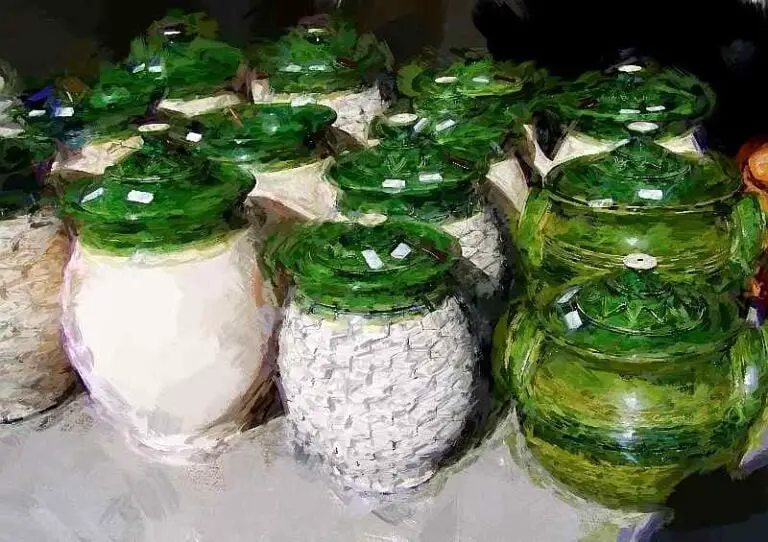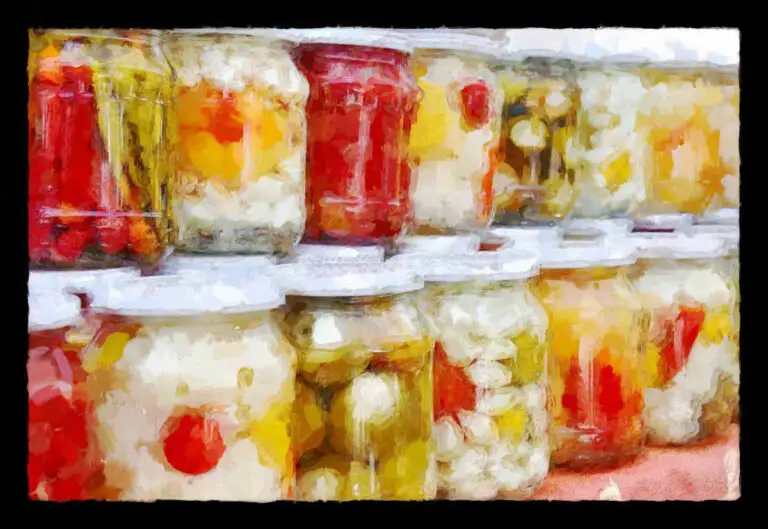Learn how to keep oxygen out of your fermenting jars. Say goodbye to moulds, Kahm yeast, food waste and spoilages; all without using an airlock.
Whether you are a fermenting beginner or an avid fermenter with years of experience, you know there is one thing you always need to take seriously: oxygen.
To put it simply, oxygen ( and salt, to be absolutely precise ) is really THE element that can make or break your fermentation process and turn hopes into sore disappointment.
You know, the colourful moulds and the kahm yeast layers we all, at least once, stared at after opening a jar of fermented vegetables?
You have found your culprit: oxygen.
But if you are here hoping to learn how to make a fermentation container airtight I am sorry to disappoint you.
It’s not what this tutorial is about.
And here is why.
An airtight fermentation container is the last thing you want, unless, of course, you are trying to have a first hand experience of an explosion.
If that’s the case there are plenty of articles on the web that will teach you how to transform a fermenting jar into an airtight environment.
But this won’t.
An Airtight Jar Is THE LAST Thing You Need
So you thought, or read, that an airtight container was the proper way to ferment your food, right?
Well, I am afraid you’ll have to rethink that one again.
Picture a glass jar, sealed so well that no gas can escape, then place “fermenting material” inside it.
What do you think will happen?
In the best of cases the pressure will skyrocket the lid into new heights and potentially spread your ferments all over walls and counter.
In the worst, your jar will crack open and often explode.
If you have had the experience, you already know how frustrating it is to lose your beloved vegetables you were so eager to eat.
At least now you know what to avoid next time: sealing your fermenting jars as tight as you possibly can.
So what do you need to do then?
Let me try to help you out.
Airtightening And Airlocking Are Two Different Things
As we have explained in our tutorial about the use of an airlock, the important thing we need to achieve inside the jar is this:
An environment where gas is allowed to flow in one direction but not in the opposite one.
Specifically, we want to create a scenario where the CO2 developing inside the container has a way to safely escape without allowing any oxygen to enter.
By doing so we create a perpetual anaerobic condition inside the jar that keeps food secure and safe to eat.
I know it might sound complicated but I promise you it is not and you will see it for yourself in just a few lines.
Just bear with me a little longer and I’ll be showing you how you can easily air lock your fermentation container without using any airlock or airlocking device.
Here we go.
The first step is to choose the easiest container to work with, which, in our experience, is a glass jar.
To know more about fermentation vessels, how they operate and how easy or difficult they are to use, you can read our tutorial.
Although many different containers could accomplish the task well, what we use and wholeheartedly recommend are the jars known as clip-top jars.
But not any clip top jar, Bormioli Fido jars.
Clip Top Jars – THE BEST Fermentation Jar
If you are not familiar with clip top jars ( also called preserving jars ), what we refer to is a very thick and durable glass jar whose lid is sealed and locked in position by a metal latch.
Together with the metal clip, the other important feature of these latch jars is their rubber gasket.
Such gasket, anchored to the inferior part of the lid, creates a very effective yet flexible seal.
In fact, metal latch and rubber gasket together make a perfect airlocking machine that, alone, can assure a 90% fermentation success rate.
For those of you interested in understanding better ( but without getting too technical and complicated ) I will quickly explain why clip top jars engineering works so well.
On the contrary, if you are not interested in this brief essay just jump a few lines forward; I promise I won’t get offended.
Clip Top Jars – A True Fermentation Machine
Assuming the rim of the jar has been properly cleaned and dried, and that the gasket is still in good condition, flexible and without cracks, here is what happens when you seal the lid:
The rubber gasket in the lid, held in position by the clip, will shape itself around the rim, seal the jar and allow virtually zero oxygen to go in.
At the same time, when pressure inside the jar increases because of CO2 being released, the rubber seal will allow the gas to exit.
As long as pressure inside the jar is higher than the one outside, there will always be an inside-to-outside flow.
Admittedly, under these circumstances, many other fermentation containers will perform just as well.
The problems occur when the two pressures are equal or, worse, when the pressure inside the jar, for Nature’s reasons, becomes lower than the one outside.
These are the cases where the absolute majority of other containers, air-releasing fermentation lids and, often, airlocks, miserably fail.
But not the clip top jars.
The low pressure inside the jar is known to create a suction effect, but, opposite to what happens with other lids or devices, such suction will make the seal even more effective.
In fact, by pulling the lid downwards, the gasket will adhere more tightly around the rim and prevent oxygen from entering the jar to an even high degree.
On the contrary, so called “easy” fermentation lids, the ones with all sorts of valves and nozzles, would have inverted the in-to-out flow and sucked oxygen in.
For the same reason, airlocks, both 3 piece and S-shaped, would have dropped whichever liquid they contained, inside the ferments.
So my advice is this: make it easier for yourself and choose clip top jars as your go to fermenting weapon of choice.
As you can see you don’t even need to get creative and put effort in making a diy fermentation jar of some description.
The clip top does it all and has it all
Now let’s take a step further in making our fermentation environment more secure and look at what we can actively do INSIDE the container.
How To Create A Secure Fermentation Environment
This following steps and suggestions are suitable for every container or jar you will be using.
Be it a preserving jar, a Mason jar, a recycled honey jar ( I often use those )or any other random container you have.
Please follow he steps ALSO if you use one of the many different fermentation lids or jars that have an inbuilt airlock.
1. Get rid of air pockets and air bubbles
FOLLOW THESE 2 STEPS TO ELIMINATE AIR BUBBLES
- Once produce and brine are inside the container take a chopstick or the handle of a fork and insert it vertically in the jar until you hit the bottom.
- Move it gently sideways and repeat the operation 4-5 times in different spots.
This simple action will release all air pockets hidden underneath vegetables and herbs.
Be gentle but thorough.
REMEMBER: leafy things, the even small ones, like fresh oregano or sage, are air bubble trappers so don’t underestimate them.
The same can be said for vegetables “with edges” , like chopped or cubed carrots and beetroots, or flat shaped ones like sliced cucumbers.
2. ALWAYS Submerge Everything
To reduce even further the chances of seeing mould and other guests floating on our beloved vegetables, we must keep them submerged by brine at all times.
REMEMBER: Always make sure to pour enough brine to cover all the produce inside the container; but always leave enough head space for gasses to expand.
Often times, though, even after covering everything so thoroughly, you will notice that some vegetables, herbs and spices begin to float.
It is 100% normal and 100% inevitable.
I’ll tell you more: the floating rebels will increase in number as soon as the fermentation starts and CO2 is being released.
So what do we do?
We have to weigh the rebels down.
USE WEIGHTS
In our jars we use both proper weights and/or anything else that can effectively maintain all the vegetables submerged.
It depends on what we are fermenting, the size of the jar and what we have handy at the time.
Usually there are two routes one can take to obtain weights: buy some already made or make your own.
If you decide to buy them, online you will easily find fermentation glass weights, silicone made weights and plastic ones ( pickle presses ) that are also used for pickles and preserves.
If, instead, you choose to make your own, you can unchain your creativity and come up with all sorts of ideas.
IMPORTANT: ONLY use food grade materials that can withstand both salinity and acidity.
If you don’t know that your weight will inevitably break down and you’ll end up eating it with your ferments.
So far in our fermenting kitchen every time we have made our own weights slash submerging devices we have never had a problem either with mould or kahm yeast.
This is what we do.
– With dry salted ferments like sauerkraut
From a very strong plastic plate we cut a disk the size of the jar ( not the mouth, the jar ), fold it slightly to insert it, allow it to open and place it on the produce.
Then we push it down enough until the disk itself is submerged by the brine.
For it to do a good job it is very important that the plastic disk is cut to the right size.
Because if cut it too small, the CO2 released during fermentation will push it upwards and you’ll begin to see vegetables poking out all around it.
This is the very reason why we do not buy glass weights nor intend to use them; they carry, in their nature, an intrinsic problem.
They are rigid and not flexible at all.
Sure enough, if you use them in jars where mouth and body have different diameters, sooner or later you’ll see your ferments start to float and be exposed to oxygen.
In place of plastic, which, to reduce pollution, we reuse many times you can cut a silicon tray or use a pickle press.
– With brined vegetables and fruit
Even though the disk method can also work with brined vegetables, there is always the chance that after a few days you will see it floating on the brine.
As the weight of a plastic or silicone disk is close to null it only takes a minimal amount of gas to push it out of place.
Don’t worry though, if you really like this method you can still apply it; all you need to do is add some form of weight on the disk.
Basically you have to weigh the weight down so to speak…
It could be a ( washed ) rock, a freeze bag full of rice or dry legumes, a glass weight and even a little container full of brine.
The way we do it is even more minimal: we simply pour some brine inside a freeze bag or a ziplock and sit it on the vegetables.
That’s it.
No disk, no extra weights, nothing.
And the system works so well because the brine inside the bag is able to spread out and cover the entire surface of the ferments.
Plus, because it has weight, the bag will cause some of the brine inside the jar to rise, climb up and fill every remaining gap.
As you can see this is a very simple and cheap way to create a superior barrier against oxygen.
But, truth be told, we are actively looking for an alternative to the freeze bag because we are fully aware that ALL plastic leaches toxic chemicals in liquids and food.
If and when we discover an equally valid alternative I will update this post for everyone to see.
As a reminder: if you want to eat safe fermented food you must make sure everything is submerged by brine at all time.
And you need to do that even if you use a lid with an air-release valve, a pickling pipe, an easy fermentation lid, a screw on lid, a mason jar…
3. Learn How And When To Burp A Jar
Raise your hand if you diligently burp your ferments once a day and sometimes more if temperatures are warm enough to call for it.
Yep, I too have done my fair share of it.
Not everyone knows this but the action of burping a jar is really more of a safety measure than a necessary step for a successful fermentation.
In fact we “burp a jar” with the only purpose of releasing gasses and prevent the container from cracking or exploding.
The downside of this action is that beside letting CO2 out, we also exponentially increase the risks of letting oxygen into the jar.
And we consequently increase the chances for moulds and Kahm yeast to grow.
Hence the importance of learning how to do it correctly and even eliminate the need for this action all together.
– How to correctly burp a jar
Let’s assume the food you are fermenting is in the CO2 releasing phase which usually occurs from day 1 to day 5.
If you are using a jar with any kind of screw on lid do as follows.
- Press the centre of the lid and check if you hear the well known psssssst sound.
- If not, gently unscrew the lid WITHOUT lifting or removing it.
That’s it.
Daily burping mission accomplished.
If, instead, you are using a clip top jar ( Bormioli Fido, Le Parfait or similar ) you don’t need to burp the ferments.
Thanks to the rubber gasket, these jars are able to self burp and are, in fact, often referred to by the fermenting community as self-burping jars.
Obviously the same applies if you are fermenting with an airlock or with one of the special lids mentioned above.
Irrespective of the tools you use, make this your mantra:
NEVER open a fermentation jar unless it’s absolutely necessary.
Mould Can Be Dangerous
If it’s true that Kahm yeast spoils the taste of fermented food but is generally considered safe, moulds are, by any means, NOT safe.
As a quick reminder: Clostridium Botulinum, known to cause botulism, is a type of mould.
But C. Botulinum is not the only problem; almost every type of ( unwanted ) mould can release mycotoxins potentially harmful to humans.
If you see ANY mould growing in and on your fermented food do not hesitate: throw everything away.
Don’t play with your health and the health of those you love.
Never attempt to just remove the moulded area thinking the rest will be fine, because there is a great chance it won’t.
Moulds begin to sporulate and colonise the ferments way before you are able to see them with your naked eye.
So when they are finally visible on thesurface it means they are also everywhere else in your ferment, even if you don’t see it.
Furthermore, if you notice mould growing while fermenting with an airlock or a fermenting lid, the safest option is to throw them away too.
Spores can be hiding in bents and corners making it very difficult to completely remove them.
I know this stuff can be worrying and, as such, should definitely be taken seriously, but please don’t let it scare you away from fermenting your own food.
Rest assured that when food is properly fermented in an ASA ( Acidic – Salty – Anaerobic ) environment the risks of mould growing are almost negligible.
Fermentation has been around for millennia and still nowadays is one of the best and safest ways to preserve all kinds of foods.
So do it properly BUT DO IT!
Fermenting food is good for you, good for the environment and it’s one of those skills we, as humans, should never abandon or dismiss.
See you soon.








Would you consider WECK canning jars with rubber gaskets and metal clips an alternative to the clip-top jars
you’ve recommended? I ask because I have the Weck & just cannot invest in more jars at this time. I’m considering Lacto-fermented garlic in a WECK with either two or three clips.
Thanks for the VERY informative post!
Hi Chandra,
we are so glad you found the article useful.
I have never used Weck jars myself but judging by how they look I would say you could use them.
Just make sure to check they self burp, if not, you will have to do that manually to avoid explosions.
Happy fermenting!
Very informative and well written article.
I have a question concerning the submerge problem. I too thought of cutting food grade flexible plastic or silicone disk to put in my jars/crocks and then weight it down. I am hesitating because I worry about salt leaching chemicals from the disk. The plastic/silicone disk is submerged, depending, 1 to 3 weeks. What do you think about using a sterilized loose weave natural linen or cotton cloth to cover the veggies. Even tucking around the sides, and then weighing down . Could this be a maybe? Or would the there be a problem with using fabric.
Hi Susanna,
what an interesting question!
We have never used fabric as a way to “insulate” our ferments so I have no direct experience but I’ll share with you the concern I have in regards to proceeding that way.
Considering that fabric is permeable it will absorb any liquid below it, transfer it to its surface (potentially exposing it to oxygen) and vice versa.
Based on that, I am afraid it could offer a very suitable environment for moulds to grow or for your food to be contaminated with unwanted microorganisms.
If I were to try that path I think I would weight it down with a fridge bag full of brine, because it is a system that offers a lot of insulation.
If you decide to give it a go, which I advise you to, maybe with a small jar that can be “sacrificed to science”, please come back and let us know hot it went. I am really looking forward to knowing about your results!
Good luck and thanks for stopping by.